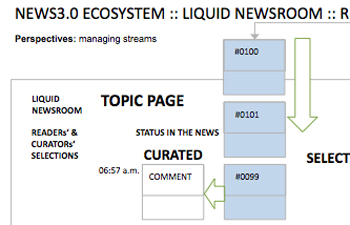People often think it’s best to hide their good ideas and develop them in secret. The goal is to beat the competition by emerging only once your concept is fully developed and ready to go. This can be the case with a new business, or a piece of journalism.
At the moment, though, people seem intrigued by the opposite approach. They say from the outset what they’re trying to do. They use social media to think about and discuss the idea out in the open. They encourage other people join in and, in doing so, help create something new and daring, something that couldn’t have been developed in secret solitude.
Liquidnews, or the Liquid Newsroom, is an emerging news project that’s all about the above strategy, radical openness. I found out about the project on Twitter via the #liquidnews hashtag. It’s where a group of people, many of whom are journalists, discuss a project for a “liquid” or a “virtual” newsroom. They talk about what a Liquid Newsroom could be, about the business model, and the technological platform necessary make it happen. They exchange tweets such as this one from Steffen Konrath: “Currently exploring ways to add Sparkbox (tonihopponen) & Clp.ly (Kinanda) to the Liquid Newsroom project #liquidnews.”
Often, the tweets consist of reaction to posts published on Konrath’s blog, Future of Journalism – News 3.0. Konrath’s day job is director of web applications at Verlag moderne industrie GmbH in Munich, Germany, and the Liquid Newsroom is his project.
On September 1, Konrath published a Liquid Newsroom Manifesto on his blog, which reads like a proposal for a kind of postmodern virtual enterprise. In his model, the relationship between the “outside” and the “inside” of a company changes fundamentally. For instance, he writes, that in this newsroom “the content is triggered by events and interest of the people, and not by the purpose of keeping a company alive.”
Or this: The “Liquid Newsroom is first a concept model for a specific type of (news) content representation and collaboration. The concept model needs a technical platform to come into existence. (curative journalism).”
All this was intriguing enough to lead me to conduct a Q&A with Konrath via Skype. An edited version of our conversation is below.
Q&A

Steffen, could you tell us something about your background?
Steffen Konrath: I’ve a background in computer sciences, IT and marketing. But also in mime and acting, which is quite an asset for telling stories.
What is the Liquidnews project about?
Konrath: Well, look at it as a platform where people can collaborate. I use the notion of Yentity: the “Y” symbolizes different, sometimes even opposing, streams and perspectives which merge into one curated stream. The “entity” can be considered as an atom of news, part of the stream. It is important that the stream is curated by a human being.
But who are the content creators?
Konrath: Even though traditional media will not disappear overnight, they will no longer play such a big role anymore. There is a lot of information and expert opinions on individual media such as blogs. The liquid newsroom could help to gather all that dispersed information.
So this implies that you’ll need a technological platform?
Konrath: Exactly. We’re reaching out to various other companies and persons [who have] experience with this. The platform must enable the curated merging of the streams, but must also be open. The communities involved should be able to see what the raw content stream is, what the curators do, what community members select. The news will be published on several portals.
Which communities will those portals target? In other words, what will they cover?
Konrath: [Showing slides via Skype] See that square in Munich? One could imagine hyper-local daily coverage of that neighborhood. Or one could launch an international coverage of a very specific subject. What is important is that the portals have a strong focus, in order to mobilize communities of interest and in order to generate revenues.
You are suggesting several possible revenue streams on your blog.
Konrath: Yes, I’m heavily in favor of a fair pay. The focus of the portals will be important. We’ve had the discussion on the blog and on Twitter about the business model, and now I even get help from students from a Munich business school.
It’s remarkable how this project, which is still very early phase, is discussed on Twitter, on blogs. Aren’t you afraid that some competitor will steal your ideas?
Konrath: There is too much preoccupation with protecting property rights. That makes collaboration more difficult, when what is really needed in today’s world is just that — collaboration. That being said, we’ll have to avoid [having] the platform appropriated and licensed by other companies, which would block the innovation. So we’ll have to look into this.
Speaking of competition, how do you see the relationship with traditional media companies?
Konrath: First of all, blogs do exist already, but no, there is no antagonism towards traditional media. Platforms such as Liquidnews will help traditional media to focus on their strong points. One could consider the portals of Liquidnews as pilot fishes.
Entrepreneurial Journalism
I don’t know whether the Liquid Newsroom project will succeed in becoming a promising start-up. What is interesting, though, is the openness that’s at the core of the project. If it succeeds, we’ll be able to study its every step on the road to success. If it fails, we’ll be able to study why and where it went wrong. The result? An even more vibrant and sophisticated new media landscape.
Visiting Konrath’s blog and reading the #liquidnews feed, you see that many questions are without a final answer. People offer related blog posts, make suggestions, and offer names of platforms for aggregating and curating news streams. It’s a process, a kind of open school for media entrepreneurs. And in the end, I think that all journalists, regardless of where they work, should consider themselves entrepreneurs.
Roland Legrand is in charge of Internet and new media at Mediafin, the publisher of leading Belgian business newspapers De Tijd and L’Echo. He studied applied economics and philosophy. After a brief teaching experience, he became a financial journalist working for the Belgian wire service Belga and subsequently for Mediafin. He works in Brussels, and lives in Antwerp with his wife Liesbeth.

